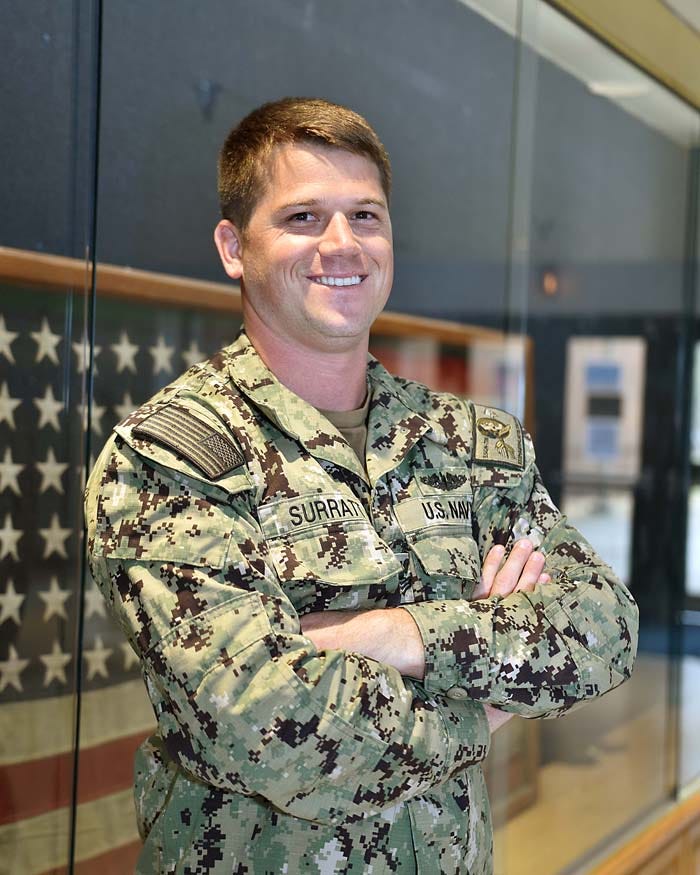KINGS BAY, Georgia — A Pace native is serving aboard the USS Florida, one of the world’s most advanced nuclear-powered submarines.
Petty Officer 1st Class William Surratt, a Pace High School graduate, joined the Navy 11 years ago.
“Being a third-generation Navy sailor and aspiring to follow in the footsteps of my mom and dad, who were both Navy chiefs, inspired me to join the Navy,” Surratt said.
Today, Surratt serves as an electronics technician (navigation), whose responsibilities include being a reactor operator.
“I supervise operations within the engine room,” said Surratt. “I also operate and perform maintenance on the instrumentation that monitors the realtor plant.”

Since joining the Navy, Surratt has enjoyed having the chance to meet and serve with sailors from all over the country and world.
“Coming from a small town, I was not exposed to people from different backgrounds and cultures,” said Surratt. “I have a great appreciation of the diversity of the sailors that work for me. I am able to use different people’s strengths to accomplish tasks.”
Known as America’s “Silent Service,” the Navy’s submarine force operates a large fleet of technically advanced vessels. These submarines are capable of conducting rapid defensive and offensive operations around the world, in furtherance of U.S. national security.
There are three basic types of submarines: fast-attack submarines (SSN), ballistic-missile submarines (SSBN) and guided-missile submarines (SSGN).
Fast-attack submarines are designed to hunt down and destroy enemy submarines and surface ships; strike targets ashore with cruise missiles; carry and deliver Navy SEALs; conduct intelligence, surveillance, and reconnaissance missions; and engage in mine warfare.
The Navy's ballistic-missile submarines, often referred to as "boomers," serve as a strategic deterrent by providing an undetectable platform for submarine-launched ballistic missiles. SSBNs are designed specifically for stealth, extended patrols and the precise delivery of missiles.
Guided-missile submarines provide the Navy with unprecedented strike and special operation mission capabilities from a stealthy, clandestine platform. Each SSGN is capable of carrying 154 Tomahawk cruise missiles, plus a complement of heavyweight torpedoes to be fired through four torpedo tubes.
As a member of the submarine force, Surratt is part of a rich 121-year history of the U.S. Navy’s most versatile weapons platform, capable of taking the fight to the enemy in the defense of America and its allies.
Serving in the Navy means Surratt is part of a team that is taking on new importance in America’s focus on rebuilding military readiness, strengthening alliances and reforming business practices in support of the National Defense Strategy.
“Being a forward-deployed asset that can operate in any area from the Mediterranean to the Indian Ocean and being a multi-use platform that can provide combatant commanders with special ops and tomahawks proves invaluable,” Surratt said.
With more than 90 percent of all trade traveling by sea, and 95 percent of the world’s international phone and internet traffic carried through underwater fiber optic, Navy officials continue to emphasize that the prosperity and security of the United States is directly linked to a strong and ready Navy. A major component of that maritime security is homeported at Naval Submarine Base Kings Bay.
“We do two big things here in King’s Bay: we send SSBNs on Strategic Deterrence Patrols and we forward deploy our guided missile submarines overseas,” said Rear Adm. John Spencer, Commander, Submarine Group Ten. “This work is essential to uphold the number one mission of the Navy: strategic deterrence. And this is the only home port for both of these types of submarines on the East Coast.”
Strategic deterrence is the Nation’s ultimate insurance program, and for decades, Kings Bay has been home to Ohio Class SSBN ballistic-missile submarines. Beginning in 2028, the new Columbia Class ballistic-missile submarines will arrive and provide continuous sea-based strategic deterrence into the 2080s.
As Surratt and other sailors continue to train and perform the missions they are tasked with, they take pride in serving their country in the United States Navy.
“I have great pride in serving my country,” Surratt said. “I feel it is one of the greatest things someone can do. We all have a responsibility to give back to our country in some way for the freedoms that are sometimes unappreciated.”
Megan Brown writes for the Navy Office of Community Outreach.
This article originally appeared on Santa Rosa Press Gazette: Pace native serves as a member of U.S. Navy’s 'Silent Service'
